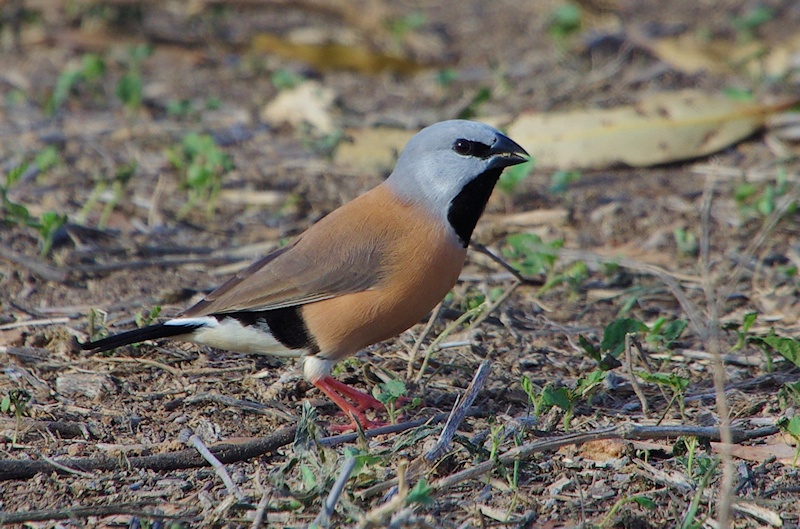The Black-throated Finch: A Closer Look At Poephila Nigrotecta
Share
The Black-throated Finch, scientifically known as Poephila nigrotecta, is a captivating bird species belonging to the family Estrildidae. This small, colorful finch is native to the northern regions of Queensland, Australia, particularly the Cape York Peninsula. With its striking appearance and unique behaviors, the Black-throated Finch is a subject of interest for ornithologists and birdwatchers alike.

Taxonomy and Classification
The Black-throated Finch is classified under the order Passeriformes, which encompasses a vast majority of bird species. Within this order, it falls under the suborder Oscines, known for their complex vocalizations. The family Estrildidae includes various small, colorful finches, and the subgenus Poepihila specifically refers to a group of finches characterized by their vibrant plumage and social behavior.
The species Poephila cincta has several subspecies, with Poephila nigrotecta being the one of particular interest. This subspecies was first described by Hartert in 1899, with its type locality being Cape York, also known as Chester River, in northern Queensland.
Physical Characteristics
The Black-throated Finch is a small bird, typically measuring around 10 to 12 centimeters in length. It exhibits a distinctive plumage, with males showcasing a striking black throat and chest, contrasting with their lighter underparts. The wings and back are adorned with shades of brown and olive, providing excellent camouflage in their natural habitat.
Females, while less vibrant than males, possess a more subdued coloration that aids in their concealment, especially during nesting. Both sexes have a short, conical bill that is well-adapted for seed consumption.

Habitat
The Black-throated Finch primarily inhabits the grasslands and open woodlands of the northern Cape York Peninsula. These areas are characterized by a mix of grassy plains and scattered trees, providing ample foraging opportunities and nesting sites. The bird prefers habitats with dense grass cover, which offers protection from predators and a suitable environment for feeding.
Due to habitat loss and degradation, the Black-throated Finch's range has become increasingly restricted, making conservation efforts crucial for its survival.
Diet
The diet of the Black-throated Finch mainly consists of seeds, particularly those from grasses and other herbaceous plants. They are known to forage on the ground, using their strong bills to crack open seeds. In addition to seeds, they may also consume small insects and other invertebrates, especially during the breeding season when protein-rich food is essential for raising chicks.

Behavior
Black-throated Finches are social birds, often found in small flocks. They are known for their cheerful chirping and melodious calls, which play a significant role in their social interactions. These birds are diurnal, meaning they are most active during the day, engaging in foraging, preening, and socializing.
During the breeding season, males perform elaborate courtship displays, showcasing their vibrant plumage and vocal abilities to attract females. These displays often involve fluttering flights and specific postures that highlight their physical attributes.
Reproduction
The breeding season for the Black-throated Finch typically occurs during the warmer months, coinciding with the availability of food resources. Nests are usually built in dense grass or shrubs, providing protection from predators. The female is primarily responsible for constructing the nest, which is made from grasses and other plant materials.
After laying a clutch of 4 to 6 eggs, the female incubates them for about 12 to 14 days. Once hatched, both parents participate in feeding the chicks, which fledge approximately 3 weeks after hatching.

Conservation Status
The Black-throated Finch is currently classified as endangered due to habitat loss, primarily from agricultural expansion and land clearing. Conservation efforts are underway to protect their remaining habitats and promote sustainable land-use practices. Organizations are working to raise awareness about the importance of preserving this unique species and its ecosystem.
Birdwatchers interested in observing the Black-throated Finch should visit the northern Cape York Peninsula during the breeding season when they are most active. Look for them in open grasslands and listen for their distinctive calls, which can help locate their presence.

The Black-throated Finch is not just a beautiful bird; it plays a vital role in its ecosystem by aiding in seed dispersal and contributing to the health of grassland habitats. Protecting this species is essential for maintaining the biodiversity of the regions it inhabits. By understanding and appreciating the Black-throated Finch, we can contribute to its conservation and ensure that future generations can enjoy its presence in the wild.